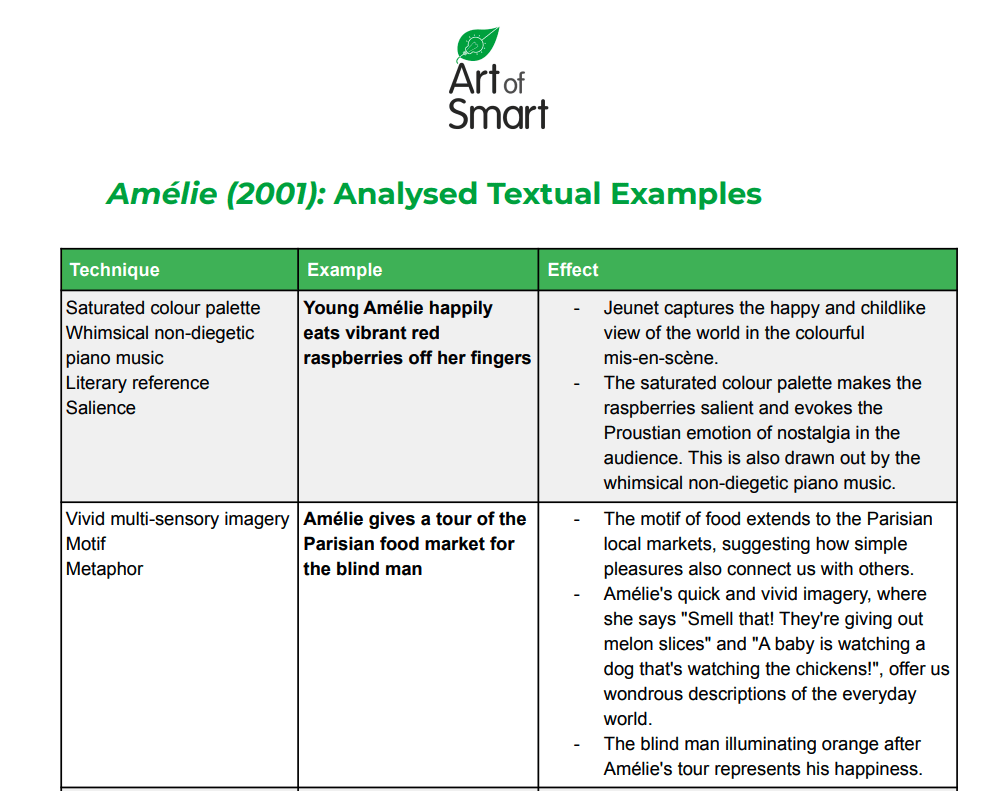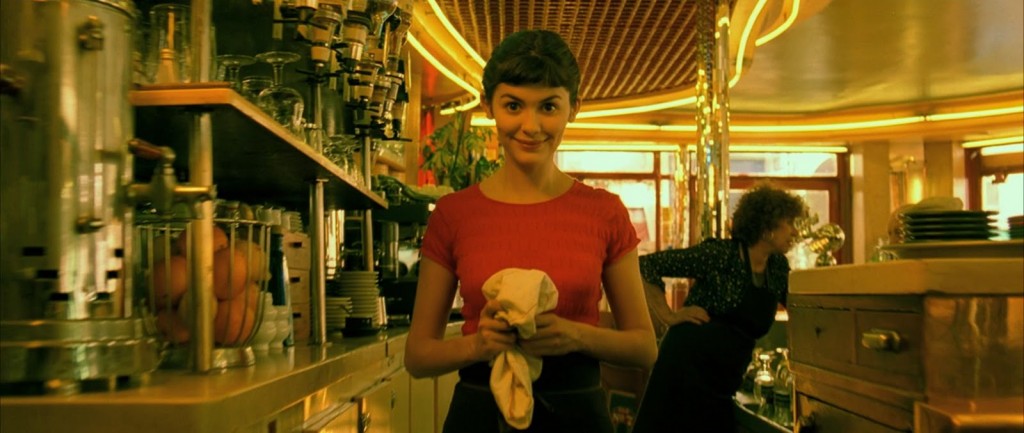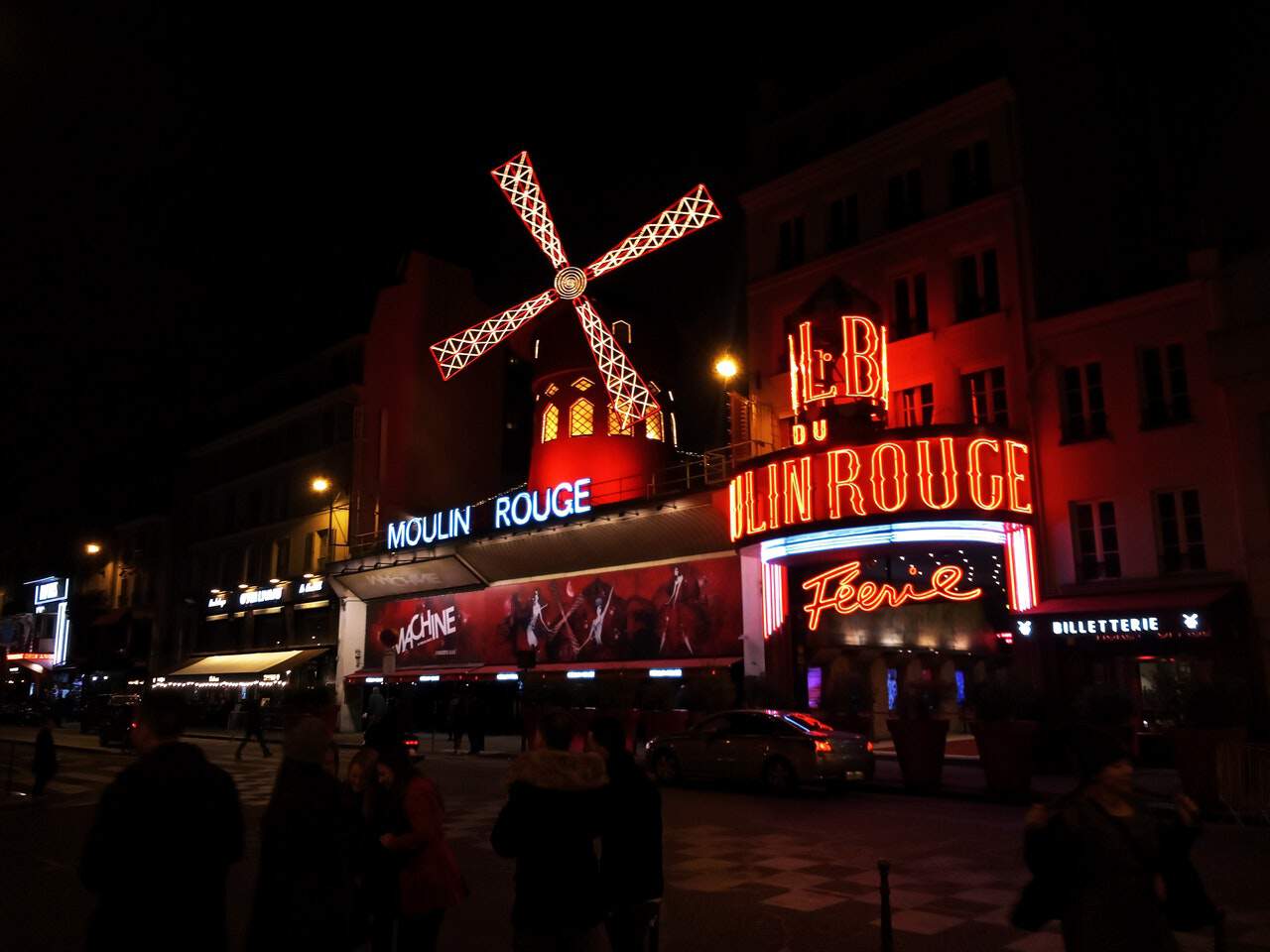Studying Amélie for English and need some guidance coming up with your analysis? We’ve got you — we’ll walk you through a step-by-step analysis of Amélie and even dive into a summary, the key characters and themes!
Plus, we’ll provide you with a sample analysis table (also called a TEE table) and a sample Band 6 paragraph for Amélie!
Ready? It’s time to ace your Amélie analysis — let’s go!
Amélie Summary
Key Characters in Amélie
Context
Themes Explored in Amélie
Analysis of Amélie
What is the story Amélie about?
Amelie Poulain is the main character of the 2001 titular French romantic-comedy film, Amélie (or The Fabulous Destiny of Amélie). The film is set in 1997 Paris and mostly takes place in Montmartre, one of the outer arrondissements of Paris where many bohemians and artists notably lived after the French Revolution.
Amelie lives in a small flat in Montmartre and works as a waitress at her local cafe, Café des 2 Moulins (2 Windmills in English), with her two colleagues, Suzanne and Georgette.
Amélie’s Childhood
The film begins with a narrated prologue of Amelie’s lonely childhood. Her father, a quiet former army doctor, who gives Amélie monthly medical check-ups, prescribes Amélie with a heart condition.
However, the narrator tells us Amelie has no heart defect and she was, in fact, only excited because her father rarely hugged his daughter.
Amelie’s mother dies in a freak accident where a suicidal Canadian tourist jumps from the top of the Notre Dame. Her father, in his mourning, becomes more and more sheltered, along with Amélie.
Amelie resorts to her active imagination, mischief and simple everyday pleasures, like dipping her hand into a sack of grain, eating raspberries off her fingers and cracking the scorched sugar topping of a crème brûlée with a teaspoon.
The prologue ends with the line “the outside world seems so dull that Amelie prefers to dream her life until she’s old enough to leave“.
Here’s a preview of the downloadable analysed examples:
Access Amélie Downloadable Sample Paragraph and Examples of Analysis here!
Amélie’s Life as an Adult
Amelie is now an adult and waitress at Café des 2 Moulins. Shocked by the breaking news of Princess Diana’s death, Amélie drops her perfume stopper that rolls next to the spot of her bathroom wall where an old box full of a child’s treasures is hidden.
She has the idea to find the owner of this box and return his treasure to him. This idea leads her to meet her neighbours — an old artist with brittle bone disease, Raymond Dufayel, and the widowed concierge lady, Madeleine Wallace.
Dufayel tells Amelie she has been searching for the wrong person, as the last name of the owner of the child’s box is Bretodeau and not Bredoteau.
Finally, leading Bretodeau back to the treasure and secretly watching his exhilaration, Amelie feels renewed and in perfect harmony with herself (in this scene, she walks across the Pont Des Arts located along the Paris’ main river, the Seine).
She decides to secretly help the lives around her. This includes helping a blind man across the street and describing in vivid detail what is going on around them.
Another is taking revenge on the mean grocer, Collignon, who abuses his worker, Lucien. At Les Deux Moulins, she sets up her hypochondriac colleague, Georgette, with a regular at the cafe, Joseph and they have a passionate but short-lived romance.
Amélie also steals a gnome from her father’s garden in a plot to pull him out of his reclusion; she gets her friend and air hostess, Philomène, to take pictures of the gnome in different countries and mail them to Amélie’s father.
Nino Quincampoix
In the midst of her plots and schemes, she meets a young man, Nino Quincampoix, who works in one of many adult-film shops in Le Pigalle, at the Paris Metro. Nino is obsessed with the strange appearance of a bald man with red shoes in many of the passport photographs discarded in the photo-booths around the city.
Amélie picks up Nino’s photo album of discarded photographs that he drops. Amélie instantly becomes infatuated with him, but rather than approaching him, she devises various games of hide-and-seek for Nino to come retrieve his album.
After her first failure to meet Nino face-to-face and confront reality, Amélie goes back to her flat. For the last time in the film, she resorts to her imagination, daydreaming of what it would be like with Nino.
Suddenly, Nino knocks at the door, with the help of Suzanne, finds Amélie’s apartment and slides her a note under the door saying “I’ll be back”.
Dufayel gives Amélie a pep talk through a VCR recording, telling her “Your bones aren’t made of glass, you can knock against life”. She finally opens the door for Nino and to the start of their new romantic relationship.
The film ends with Amelie and Nino together cycling around the streets of Montmartre and the famous church, Sacré-Cœur.
Key Characters in Amélie
Amélie Poulain
A 24-year-old woman from Montmartre who works as a waitress at Café des 2 Moulins. From having a solitary childhood of homeschooling, Amélie imagines life in a magical kind of way.
To combat her loneliness as an adult, she performs good but secret deeds for the people in her life. In doing so, she is forced to finally overcome her shyness and eventually finds love herself.
Nino Quincampoix
A young man who is equally as peculiar as Amélie. Similarly to Amélie, Nino had a tough childhood and was bullied by his classmates.
He works two jobs, one at the haunted ride at an amusement park and the other at an adult-film store at La Pigalle. He collects the discarded passport photographs in photo booths all over Paris and finds out that a bald man with red shoes is in many of the discarded photographs.
Raphaël Poulain
Amélie’s father. He is a taciturn man who struggles to communicate openly with Amélie. Because of this, he only grows more and more reclusive after his wife’s (Amélie’s mother) death.
He is brought out of his solitary life and decides to travel in his retirement when Amélie devises a plot to mail photographs of his gnome in foreign countries.
Amandine Poulain
Amélie’s mother. Stern, nervous and overprotective over Amélie. She dies in a freak accident when Amélie is 6.
Raymond Dufayel, “The Glass Man”
Amélie’s elderly neighbour and artist who has brittle bone disease. Because of his condition, he stays in his flat where he religiously repaints Renoir‘s Luncheon of the Boating Party each year.
He cares and keeps an eye out for Amélie and Lucien, who are both young and sensitive people.
Collignon
The mean grocer at Amélie’s local “épicerie”, or fruit and vegetable stall. He bullies his worker, Lucien, for being a bit “dumb”.
Lucien
A kind, but a little different, man who works at Collignon’s fresh-produce stall. He also takes lessons from Dufayel on how to oil paint.
Madeleine Wallace
Amélie’s neighbour and concierge lady for the flat. She is a widow to her husband who had multiple love affairs before dying in a plane accident that was bound for South America.
As part of her good deeds, Amélie forges a fake letter from Madeleine’s husband that professes his love for Madeleine to give her closure.
Dominique Bretodeau
A man in his early 40s who lived in Amélie’s flat when he was a child. After finding his old childhood treasure box, he is inspired to reconnect with his daughter and grandson.
Gina
Waitress at Les Deux Moulins and Amélie’s colleague. She helps Nino find Amélie after Amélie shies away from their first date.
Suzanne
Owner of Café des 2 Moulins.
Georgette
Amélie’s colleague and hypochondriac.
Joseph
Regular at Café des 2 Moulins who tape records his insults to the women. He stalks his failed romantic interest and waitress at the cafe, Suzanne. He also has a short-lived romance with Georgette.
Hipolito
A failed writer and regular at Café des 2 Moulins.
Philomène
Amélie’s friend. An air hostess who takes the gnome in Amélie’s father’s garden around the world and mails pictures of it back to Amélie’s father.
Context
Although the plot and magical elements of Amélie makes the film a little absurd, there’s more to grasp in the film if we are given the context.
These include a nostalgia for early twentieth-century Paris, a homage to French New Wave cinema and the importance of food as memory.
Nostalgia for old Paris
To understand the social and cultural context of Amélie, it’s good to note that Jean-Pierre Jeunet (the director of Amélie) was living in California prior to filming Amélie and was homesick. He therefore wanted to capture a nostalgic image of Paris.
He uses many of Paris’ cultural institutions, such as the café and other important French food stores, as well as stereotypically “French” people.
Jeunet also responds to the problems of modern society at the turn of the twenty-first century — globalisation, loneliness, crime and unemployment were all growing in Paris and seemed impossible for ordinary individuals to change.
He turns to the little things for happiness, such as everyday pleasures and returning to our childlike habits. Like his character, Amélie, the way Jeunet searches for happiness in the film avoids modern reality.
Jeunet’s version of Paris is very much a “fairy-tale Paris”. We don’t hear the screaming honks and sirens ongoing in Parisian traffic. We don’t see tourists, street beggars or dirty metro stations (and thankfully we also cannot smell the Parisian streets).
The fairy-tale Paris can be a little problematic at times. Montmartre, and the whole of Paris for that sake, is a very multicultural city. However, the names of more ethnically diverse characters such as Lucien and Nino are respectively given no last name and a stereotypically French last name, “Quincampoix”.
Instead, the characters we encounter in Cafés des 2 Moulins have eccentric “Parisian” qualities, who add typical French humour.
Suzanne has a limp because her lover was careless. Georgette, the hypochondriac, and Joseph, once rejected by Gina, hit it off. And, of course, there is the writer, Hipolito, who is a nod to the relationship between the Parisian writer and cafés.
The 2 Moulins is a reference to the café, les Deux Magots, where the Parisian writer, Sartre, used to work.
Food and Memory
French philosopher and novelist, Marcel Proust, had written about the powerful relationship between food and nostalgia in his book, In Search of Lost Time — there is a very famous scene of his character eating a madeleine (a type of French breakfast cake) and remembering his childhood.
Amélie captures this “Proustian” spirit through the focus on French food in the film. The montage of young Amélie eating raspberries off her fingers is a nod to the power of food on our memory. This portrays Jeunet’s larger nostalgia for Paris life devoid of modern problems.
Amélie’s “second home” is the café, one of Paris’ oldest cultural institutions, as well as the local épicerie where Collignon and Lucien work. The whole street of small food boutiques like the patisserie, a cheese store (fromagerie) and pork-butcher shop (charcuterie) is shown when Amélie gives a tour to the blind man.
These traditional food places are all important parts of everyday living that speak to the French cultural identity — Amélie’s last name, Poulain, is in fact an old French chocolate brand!
Classic French Cinema
Lastly, there are references to classic French cinematic tradition that add to the nostalgic vision of Amélie. In particular, filmic techniques of French New Wave cinema are often used such as handheld cameras, long takes, location shooting and jump cuts.
Here’s a preview of the downloadable analysed examples:
Access Amélie Downloadable Sample Paragraph and Examples of Analysis here!
Themes Explored in Amélie
There is a heavy sense of hope and nostalgia in Amélie which can be explored in various themes, including:
1. Magic in Everyday Life
“Amelie” is a cinematic masterpiece that beautifully captures the essence of finding magic in the mundane. Director Jean-Pierre Jeunet masterfully weaves enchantment into everyday scenarios, making even the simplest moments feel extraordinary.
One notable scene showcases Amelie’s ability to make a blind man experience the world through touch and sound, transforming a routine trip to the market into a whimsical adventure.
Through whimsical cinematography and clever use of color palettes, Jeunet paints a picture where magic lurks around every corner, reminding viewers to embrace the enchantment hidden within the ordinary.
2. Compassion vs. Loneliness
In “Amelie,” compassion serves as a powerful antidote to loneliness. Amelie, despite her own struggles with isolation, finds solace in bringing joy to others.
From reuniting a box of childhood treasures with its owner to orchestrating a series of small acts of kindness for her eccentric neighbors, Amelie’s compassionate actions ripple through the lives of those around her, breaking down barriers of loneliness and fostering connections.
Through poignant cinematography and heartfelt performances, the film highlights the transformative power of compassion in alleviating the profound sense of isolation that plagues the human experience.
3. The Past vs. the Present
“Amelie” beautifully explores the interplay between the past and the present, emphasizing how our personal histories shape our perceptions of reality.
Through whimsical flashbacks and nostalgic montages, the film delves into Amelie’s childhood traumas and their lingering impact on her adult life. Yet, amidst the nostalgia, Amelie learns to reconcile with the past and embrace the present moment.
4. Nostalgia vs. Conformity
In “Amelie,” nostalgia and conformity clash as Amelie navigates the tension between longing for the past and forging her own path forward. Set against the backdrop of a rapidly changing world, Amelie finds herself torn between conforming to societal norms and staying true to her whimsical nature.
Scenes depicting Amelie’s longing for simpler times and quirky montages of Parisian life evoke a sense of nostalgia, while her rebellious acts of nonconformity challenge societal expectations.
Through visually stunning cinematography and nuanced character development, director Jean-Pierre Jeunet invites viewers to ponder the delicate balance between nostalgia and individuality in a world that often demands conformity.
Looking for more insights into the film’s themes and meaning? Check out this interview with the director of Amélie for more!
How to Analyse Amélie in 3 Steps
Often students will try to start with their thesis when trying to answer an essay question. Instead, start with your analysis! You need to equip yourself with the knowledge of your text before you can answer anything about it.
After you’ve analysed your text, you can draw ideas from it, then you can build your thesis!
We’re going to walk you through creating an analysis for ‘Amélie’ in three simple steps!
Step 1: Choose your example
The best way to choose an example is to find a technique. The technique is the key to unlocking deeper meaning in a text, which you will need in your analysis.
We have chosen to analyse an early mis-en-scène of young Amélie eating red raspberries off her fingers. We’ll use this scene to explore how Jeunet explores how finding magic in everyday life can help individuals against the struggles of modern life.
Step 2: Identify your technique(s)
When trying to find a technique within your example, it’s not about finding the fanciest technique or just any old technique for that matter!
It’s about identifying a technique which will enable you to say something about your idea that’s interesting and can contribute to your argument and analysis.
Try to focus on finding examples with techniques which unveil a deeper meaning like metaphors, similes, figurative language, connotations, symbolism and recurring motifs. Other techniques like alliteration and repetition are a bit harder to find a deeper meaning in!
We have identified 4 techniques in the raspberry scene above: saturated colour palette, non-diegetic piano music, literary reference and salience.
It’s always great to try and find multiple techniques in your quotes as it allows you to take your analysis up a notch!
Step 3: Write the analysis
When you write the analysis, it is important to always focus on what the effect of the technique is. One of the worst things you can do when writing analysis is technique labelling. Technique labelling would look like this:
The prologue scene where young Amélie eats raspberries off her fingers is emphasised by a saturated colour palette and non-diegetic piano music.
Instead of this we need to flesh out how each of those techniques get us to our point. We need to show how these techniques make the audience feel.
Namely, it makes us feel nostalgic but also happy. We can link the sense of nostalgia to the context of Proust’s madeleine moment to show the marker how Amélie’s raspberry scene is a literary reference as well (see above in Context). So if we include all that in our analysis it looks like:
In the prologue scene, the saturated colour palette of the homey mise-en-scène makes salient the act of eating raspberries, where Jeunet captures the Proustian spirit of nostalgia in Amélie’s childhood. This evokes a sense of innocent childlike happiness in the audience that is further drawn out by the whimsical non-diegetic piano music.
Here’s a preview of the downloadable analysed examples:
Access Amélie Downloadable Sample Paragraph and Examples of Analysis here!
There you have it!
With all we’ve covered on Amélie, from the summary to key characters, themes and context, you’ll create a well-written analysis of the film! Good luck with your essays!
Need some help analysing other texts?
Check out other texts we’ve created guides for below:
- Romeo and Juliet
- Lord of the Flies
- Rear Window
- Hamlet
- Jane Eyre
- In Cold Blood
- Persepolis
- To Kill a Mockingbird
- The Book Thief
- The Tempest
- Blade Runner
- Fahrenheit 451
Are you looking for some extra help with your Amélie analysis?
We have an incredible team of QCE tutors and mentors!
We can help you master your analysis of Amélie by taking you through the summary, key characters and themes. We’ll also help you ace your upcoming English assessments with personalised lessons conducted one-on-one in your home or online!
We’ve supported over 8,000 students over the last 11 years, and on average our students score mark improvements of over 20%!
To find out more and get started with an inspirational QCE tutor and mentor, get in touch today or give us a ring on 1300 267 888!
Lynn Chen is a Content Writer at Art of Smart Education and is a Communication student at UTS with a major in Creative Writing. Lynn’s articles have been published in Vertigo, The Comma, and Shut Up and Go. In her spare time, she also writes poetry.










